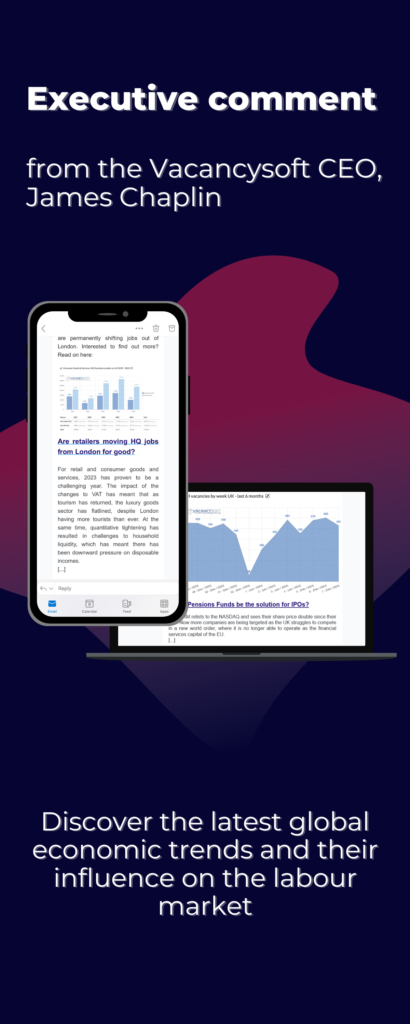SAP – UK Tech Labour Market Trends Report, April 2025
From Customisation to Configuration: SAP Jobs Pivot as Automation Bites

Key findings include:
- Consulting demand surges as firms prepare for 2027 shift; hiring up 25.1%.
- SAP architects up 100.6% as automation sidelines legacy analyst and specialist roles.
- Slovakia leads regionally with 186.6% YoY surge in SAP hiring.
- EPAM hiring up 162.3% YoY, driven by S/4HANA conversion services.
DOWNLOAD THE REPORT
DOWNLOAD THE REPORT
The twilight of SAP ECC is proving to be a catalyst for hiring—albeit unevenly. With fewer than two years remaining before mainstream support ends in 2027, more than half of all SAP clients across Europe now face a complex and costly transition to S/4HANA. The result is a spike in demand for consultants, architects and system managers able to shepherd businesses through the digital switchover.
In 2024, SAP-related hiring across the continent surged by 72.6% in the first quarter and 91.4% in the fourth, as migration planning began in earnest. The momentum has carried into 2025, with a 25.1% year-on-year rise in recruitment. Consulting leads the charge, as companies attempt to reconcile legacy architecture with the cloud-first model of S/4HANA. Yet the effects are far from universal. In Britain, economic headwinds and changes to national insurance contributions prompted many firms to delay switching, resulting in a 27.7% drop in SAP vacancies over the same period.
From back office to boardroom
Hiring patterns reveal which sectors are adapting most readily. The technology industry—already familiar with agile systems and modular thinking—posted the sharpest increase in SAP roles, up 39.1% in 2024. Startups and smaller firms, drawn to HANA’s cloud-native flexibility, have led adoption. Others are catching up. Accounting and consulting roles saw a 25.6% increase in January 2025 alone, while retail and consumer goods posted a 29.6% rise in SAP-related hiring last year.
Unsurprisingly, the most acute demand has centred on SAP consultants, tasked with tailoring new systems to old workflows. Hiring for SAP managers and administrators climbed 67.1%, reflecting the new operational requirements introduced by HANA’s architecture. SAP architects saw the largest relative gain—up 100.6%—as firms reengineer their ERP infrastructure for the cloud. In contrast, automation has rendered some roles obsolete. SAP specialists, once critical to heavy customisation, are being displaced; hiring fell 21.4% in 2024. SAP analysts are also waning, with embedded AI analytics reducing the need for manual reporting. That hiring declined 8.4% last year, and further falls seem likely.
A tale of two Europes
Regionally, SAP’s native Germany remains the largest market, accounting for 25.6% of demand. But it is no longer the most dynamic. Demand there fell 2.1% in 2024 as early adopters completed their transitions and industrial firms faced rising input costs. France, helped by digital reform and relative economic stability, grew modestly by 2.5%. Smaller economies, however, are proving unexpectedly bold. Slovakia led the charge, posting a 186.6% increase in SAP hiring last year, bolstered by foreign investment and public-sector incentives.
Capital cities have become strongholds of demand. While national figures have cooled in places like Germany, Berlin saw an 18.9% increase in 2024. Bratislava and Sofia posted far more dramatic gains—223.8% and 108.6% respectively—reflecting the urban shift toward service-based industries and startup ecosystems. The geography of SAP demand is being redrawn, not just by economic strength, but by technological readiness.
Competitive edge through capability
Companies that moved early to capitalise on the shift are now reaping the benefits. EPAM Systems, a software engineering firm, saw a 162.3% rise in SAP hiring, thanks to its S/4HANA “conversion factory,” which promises a full migration in just 16 weeks. KPMG also grew aggressively, expanding SAP roles by 98.8% after partnering with IBM and joining SAP’s PartnerEdge programme.
Not all firms are leaning in. Capgemini saw a marked decline in SAP hiring, having already built up capacity in past cycles. Instead, it is redirecting resources toward AI and cloud innovation—suggesting that, even in transition, strategy trumps scale. As the 2027 deadline looms, the SAP hiring race is no longer about headcount alone, but about who can guide clients across the digital threshold fastest—and most profitably.
Access the full report to boost your recruitment strategy with the latest market data!
All data featured in this report is available in the Vacancy Analytics platform, which is updated in real-time and allows for interactive analysis, giving you the power to drill into trends to identify the key insights you need to power your business.
If you would like to book a consultation with us to analyse trends in your market, you can schedule one here.


